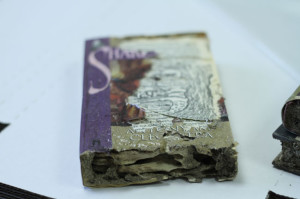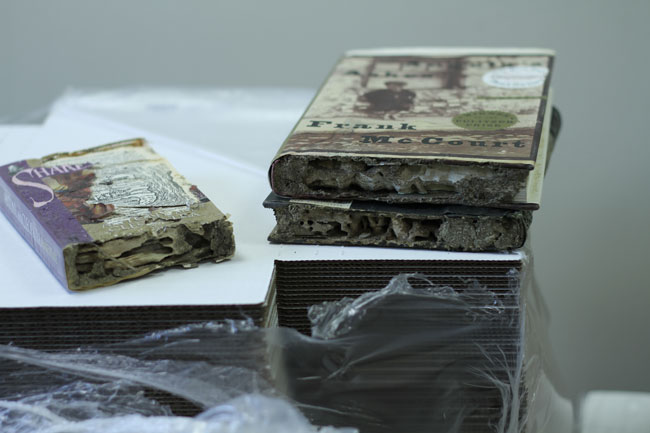Preventing Termites in Massachusetts and New Hampshire Part Two
By Chris Williams on July 1, 2014.
Katlyn Graham: I feel for these people who have just bought a house, walk in to this situation. That’s a tough…I’m sure that happens during sales. When there’s an inspection, people find out there’s a lot of termite damage. How do you prevent termites in your home to begin with?
Tim Chace: That’s also an excellent question. Again, it starts with basic home maintenance, keeping an eye on your property, making sure that everything’s in good upkeep, limiting wood to soil contact, removing food sources as much as possible, like old stumps, landscaping timbers, buried tree roots, anything you can think of that termites would enjoy. If you remove that from the property, you’re knocking down a lot of their potential.
Katlyn: Remove it from the property, not just move it away from the house?
Tim: Right, thinking about how you store things like firewood piles. A lot of times, I come out and they’ve erected a shed type of structure over the firewood pile. The firewood pile is basically just sitting on the dirt. They never even get to the bottom row. Every year, they put new wood in there and put it on top of the old wood. Then, they’ll notice that there’s damage from termites in the shed, and I’ll find out that the entire bottom row has just been digested by termites. It’s a lot of commonsense in a lot of ways. Simply, lifting wood four or five inches up off the soil will prevent termites from finding it in most cases. Even a couple of cinder blocks and a two‑by‑four will do a lot there.
Thinking about what your landscaping choices are, how close you plant shrubs and bushes to the house, are you holding a lot of moisture next to the structure? Is there a moisture problem at your house? Are the gutters functioning properly? Is the moisture being taken away from the property? Are there leaks behind the front door? Termites would love to have some moisture. Any type of termite situation is exacerbated by moisture of any kind. If they can keep their wood that they’re eating moist and survive up in the structure longer, they’ll do more damage every time. Some of the worst damage we see is usually involved with some type of moisture problem.
Katlyn: Really? A leaky faucet or…?
Tim: Or, something like that. Let’s say, every time it rains, a little bit of water shows up on the floor by the front door. It’s probably seeping in somewhere else, too, where you just don’t know. Leaky pipes, though, like you say, a faucet just dripping outside, it might bring the termites that have been looking for moisture right to that area. You’ve attracted termites to that part of the yard. Bark mulch is something that I don’t really recommend. It’s basically laying termite food around your house.
Katlyn: [laughs] Really?
Tim: If you were a swarming termite and you landed in chopped wood, it would be just like landing in a free house. This one’s for free. It’s on us. Once the colony develops, it starts off with just the two, and moves onto 400 or 500 termites the first year. They don’t have a big territory, so they’re not going to attack your house that year. They’re just eating bark mulch. In three or four years, when they have 50,000 folks looking for food, they find that gap behind the front step, key off on that moisture by the faucet. They’ve found the furnace room underneath to bring them a little moisture in the winter, and now, they’re up behind the foam that’s all around the house.
It’s a recipe for disaster if you let it go, so frequent inspections, poking around your house, good upkeep, limiting moisture, keeping wood and soil as far apart as possible, creating inspection within the structure. There’s a whole industry in the tropics where your baseboards are removable, and there’s little hatches that open into walls so that you can see where the plumbing goes through the floor.
When we were doing inspections in Hawaii many, many years ago, it would be a two‑man process. One of the guys would go ahead and open up all these little hatches and panels. There’d be a diagram for every house, and then the inspector would come in behind that and inspect all of this. Right behind him would come the man again and close all the panels. It would just take us about an hour to pretty much go through a house a couple times a year. In Hawaii, we would find something every other time.
Katlyn: Wow.
Tim: Termites in New England are a little bit less aggressive. It’s a different species altogether. We’ve got the reticulitermes flavipes. It’s a very mild little fella, if you will. His territory before the last ice age was all the way up into the Canadian wilderness. They’ve found little termite bodies in the amber up there that are the exact same species, if not something just prior to it, evolutionarily. These termites have their range all the way down past Virginia, and almost to the Midwest by Missouri. It stops there and another termite takes over in that area, but it’s a pretty wide swath for the eastern subterranean termite.
There can be up to 12 colonies per acre or more. If you envision a little field where they’ve just cut down all the little trees but they didn’t take out all the little stumps, there could be a colony that forms near every one of those, or one colony that’s really having a good time.
Eventually, those food sources will be exhausted, so that activity, their feeding, forces termites to constantly look for new food sources, which is why they stumble across your house. As they look around the foundation for the next fallen limb or whatever, they can find, which is only wood food sources, they’ll investigate the cracks between your foundation and the bulkhead, the crack between the front steps, the crack between the basement steps and the house, any little opening.
Fireplaces are sometimes constructed within the structure itself, or the chimney structure will be just adjacent to the structure with the little crack. Those are areas that are critical for inspection. Places that the termites will have secret access to the house are critical to look for. In some cases you can’t see those areas. If you’ve got a finished basement, you may have very limited access to what you want to see, there are some impediments to any termite inspection. One of the ones that I’ve been finding lately is this foam insulation that goes down along the footing. Then, there’s a beautiful attractive skim coat.
It looks like you’ve got a cement foundation, but in actuality there is a layer of…I’m not sure what the foam is made of, but it’s not cellulose. The termites actually don’t eat the cellulose, but they are able to tunnel through it. As they enjoy tunneling through this, they can also hold moisture in there. There’s a little gap between the foam and the house. When termites find what they’re looking for upstairs, boom. They’ve got a secret access into the structure. It’s moist. Even more importantly and scarily no one can see the activity until something happens.
Another thing that we look for when we’re digesting and looking for termites or diagnosing these problems is soil out of place, like I mentioned earlier. Wherever termites work they’ve got to seal up little openings that they make if they break through, say, paint or wallpaper as a case I just had. I’ve seen them come out of actual pictures. They move the picture frame, and there are swarmers coming right out of the actual wall there.
Katlyn: Or books. You brought the books [laughs] here.
Tim: We have the books right here.
Katlyn: We have the pictures, yes. What happened there?
Tim: These books were sitting on a bookshelf right above where the termites had swarmed. They had been sitting there for several years with the termites eating them as it turns out because the wood right below the bookshelf was wavy. She was planning on maybe repainting that, but she had left that for a little while. When we pulled the books up, you could see that there were actual termites feeding inside on the paper of the books. It filled the bases of the books with the actual tunnel‑construction material, that mixture of feces, saliva, and little bits of wood material.
It’s quite fascinating. It almost offers you a window into the termites’ world where no one really ever sees except them, and they don’t see it either. They operate in the dark. The termites never see what we get the privilege to see, but they construct these tunnels. She had a swarm inside the basement, and these books were pretty well eaten up.
Katlyn: Yeah. [laughs]
Tim: As it turns out the wall down in behind that is probably pretty much eaten up as well. It looks like we’re going to find some interesting stuff when they tear that bookshelf apart before the sale of the home. In the furnace room, we also found some pretty localized damage next to where the chimney was. You could see that the termites had been involved with that section of the house for at least 10 or 15 years. The saving grace was it was right above the furnace, it was relatively dry. The termites were having a hard time keeping that moist.
Katlyn: Gosh, she has some reconstruction to do before she sells that home.
Tim: It sounds like it.
Katlyn: Thank you so much for explaining all this, Tim.
Tim: You’re welcome.

